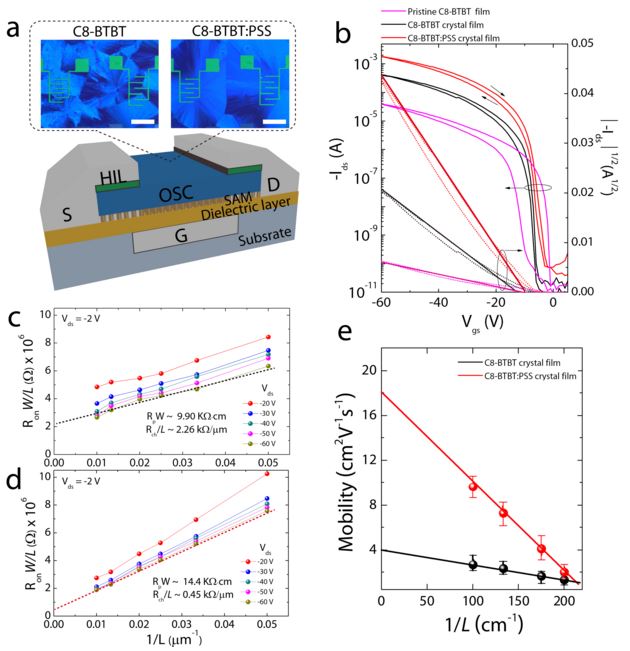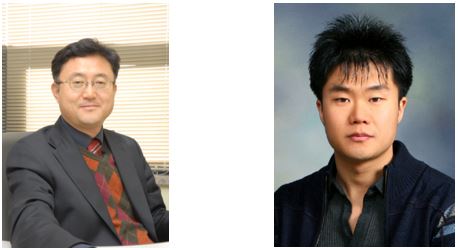Media Center
A multimedia mosaic of moments at GIST
GIST Excellence
[Press Release] Research team led by Professor Kwanghee Lee has developed a new strategy to control nucleation dynamics for long-range-ordered organic single-crystal films
- 엘리스 리
- REG_DATE : 2015.11.02
- HIT : 788
Template-mediated molecular crystal seeds are used to create more efficient organic single-crystal semiconductor films
Research published in Advanced Materials represents a significant step toward the development of high-performance plastic electronics
GIST (Gwangju Institute of Science and Technology) researchers are developing organic semiconductors to one day replace more traditional inorganic semiconductors. However, to accomplish this feat, organic semiconductors must become more efficient--and reliable--in carrying electrical currents. One drawback for organic semiconductors is that their crystalline structure tends to have imperfections that can create grain boundaries between the crystallites. These grain boundaries are essentially molecular fractures between the crystallites that decrease electrical conductivity by making it more difficult for electrons to pass through the crystalline structure.
The crystalline structure for organic semiconductors can be formed using a solution process that turns a liquid solution into a solid crystal. This phase transition from a liquid to a solid requires a heat transfer that allows the liquid solution to recrystallize itself into a solid crystal. However, controlling the recrystallization process (i.e. the nucleation and growth the crystalline structure) is very difficult, and researchers at GIST have developed a new strategy to control nucleation dynamics for long-range-ordered organic single-crystal films.
Because the nucleation and growth process can proceed more efficiently at lower undercooling when artificial crystal seeds are present, the new strategy implemented by researchers at GIST involves the introduction of robust, un-deformed organic crystal seeds into the supersaturated organic solution to assist the heat-transfer-induced phase transition. The researchers call this approach template-mediated molecular crystal seed (TMCS), and the researchers used poly(4-styrene sulfonic acid (PSS) as the TMCs template. The PSS helps to promote the formation of long-range-ordered organic single-crystal films prior to the random creation of spontaneous nucleation and growth processes by reducing the initial nucleation energy barrier during the phase transition. The result is a new strategy to control the nucleation dynamics for long-range-ordered organic single-crystal films with excellent charge-carrier mobility.

(Figure 1). a) Schematic of a C8-BTBT semiconductor fi lm and a PSS molecule on a substrate, where electrostatic intermolecular interactions are induced between C8-BTBT and PSS. Spheres in the enlarged figure represent the C8-BTBT and PSS groups; red and blue spheres correspond to sulfur and oxygen atoms, respectively, within the molecule. The dotted lines represent possible intermolecular interactions between C8-BTBT molecules (green) and/or C8-BTBT:PSS (blue). b, c) Sequential polarized optical images of C8-BTBT and C8-BTBT:PSS films, respectively, recorded as a function of time at 30 frames per second after the samples were annealed at 125 °C for 2 s and immediately cooled. The chemical structures of C8-BTBT and PSS are indicated within the first optical image at 0.00 s. d) Crystal growth rate of a representative crystal domain in C8-BTBT and C8-BTBT:PSS films. The inset indicates the Gibbs free energy change (Δ G ) for the nucleation of C8-BTBT and for the TMCS-induced nucleation of C8-BTBT:PSS. e, f) Polarized optical microscopy (upper panel) and atomic force microscopy images (bottom panel) of the final stage of the nucleation-and-growth process in the C8-BTBT and C8-BTBT:PSS crystal fi lms, respectively. All scale bars in the images are 500 μm.
The research, led by Professor Kanghee Lee of the School of Material Science and Engineering and of the Research Institute for Solar and Sustainable Energies (RISE), was conducted by Dr. Sooncheol Kwon, and their paper entitled "Organic Single-Crystal Semiconductor Films on a Millimeter Domain Scale" was published on October 1, 2015, in the online edition of Advanced Materials. This research was supported by a National Research Foundation of Korea (NRF) grant funded by the Korea government (MSIP). Experiments at PLS were supported in part by MSIP and POSTECH. Assistance for device fabrication and characterization were provided by the Heeger Center for Advanced Materials (HCAM) and the Research Institute of Solar and Sustainable Energies (RISE), both of which are at the Gwangju Institute of Science and Technology (GIST).

Professor Kanghee Lee said, "Not being able to control the nucleation and growth process for organic semiconductor films with a long-range-ordered crystal structure is the most significant barrier in commercializing organic semiconductors because failing to do so results in inferior performance when compared to inorganic semiconductors. Therefore, our research represents a significant step towards the development of high-performance plastic electronics."